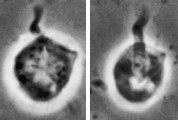Apusomonas australiensis
David J. PattersonIntroduction
This species of Apusomonas has a pointed bulge at the left anterior corner of the theca. It also has a very flexible mastigophore. It has been reported from Australia.
Apusomonas australiensis is distinguished from A. proboscidea, the only other species in the genus, because of the projection from the anterior margin of the cell and because the mastigophore is more flexible and snake-like. Other characters of the two flagellates are very similar. A. australiensis is much more abundant than A. proboscidea, and intermediate forms were never observed.
Characteristics
This species is 6 - 10 µm long, dorso-ventrally flattened, irregularly ovate in outline, asymmetrical. The right side more rounded than the left, because the left anterior corner has a pointed bulge. The mastigophore is very flexible. It is approximately the same length as the cell and arises in a cavity about one third of the cell length from the posterior end. The ensheathed anterior flagellum arises at the distal end of the mastigophore, and sheath plus flagellum is about half the cell length and about half as broad as the mastigophore. The distal third to quarter of the anterior flagellum is not ensheathed. A collar-like structure is seen where the mastigophore leaves the cell. The nucleus is situated posteriorly, a contractile vacuole is located in the mid-left-hand side of the cell. The cell glides over the substrate with a speed of about 10 µm/s. The ensheathed anterior flagellum beats rapidly to the left, the stroke covering an angle of about 45°.
References
Ekelund, F. and Patterson, D. J. 1997. Some flagellates from a cultivated garden soil in Australia. Archiv für Protistenkunde 148:461-478.
Title Illustrations

| Scientific Name | Apusomonas australiensis |
|---|---|
| Specimen Condition | Live Specimen |
| Copyright | © 2000 Flemming Ekelund |
About This Page
David J. Patterson

Marine Biological Laboratory, Woods Hole, Massachusetts, USA
Correspondence regarding this page should be directed to David J. Patterson at
Page copyright © 2000 David J. Patterson
 Page: Tree of Life
Apusomonas australiensis .
Authored by
David J. Patterson.
The TEXT of this page is licensed under the
Creative Commons Attribution License - Version 3.0. Note that images and other media
featured on this page are each governed by their own license, and they may or may not be available
for reuse. Click on an image or a media link to access the media data window, which provides the
relevant licensing information. For the general terms and conditions of ToL material reuse and
redistribution, please see the Tree of Life Copyright
Policies.
Page: Tree of Life
Apusomonas australiensis .
Authored by
David J. Patterson.
The TEXT of this page is licensed under the
Creative Commons Attribution License - Version 3.0. Note that images and other media
featured on this page are each governed by their own license, and they may or may not be available
for reuse. Click on an image or a media link to access the media data window, which provides the
relevant licensing information. For the general terms and conditions of ToL material reuse and
redistribution, please see the Tree of Life Copyright
Policies.
- First online 18 September 2000
Citing this page:
Patterson, David J. 2000. Apusomonas australiensis . Version 18 September 2000 (under construction). http://tolweb.org/Apusomonas_australiensis/20503/2000.09.18 in The Tree of Life Web Project, http://tolweb.org/










 Go to quick links
Go to quick search
Go to navigation for this section of the ToL site
Go to detailed links for the ToL site
Go to quick links
Go to quick search
Go to navigation for this section of the ToL site
Go to detailed links for the ToL site